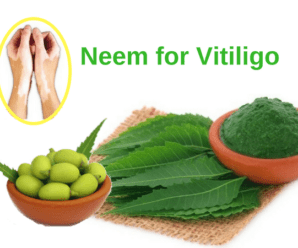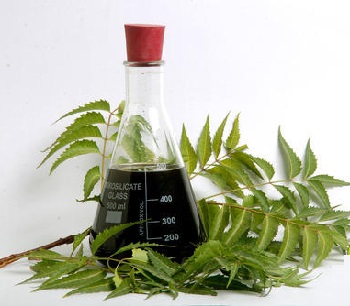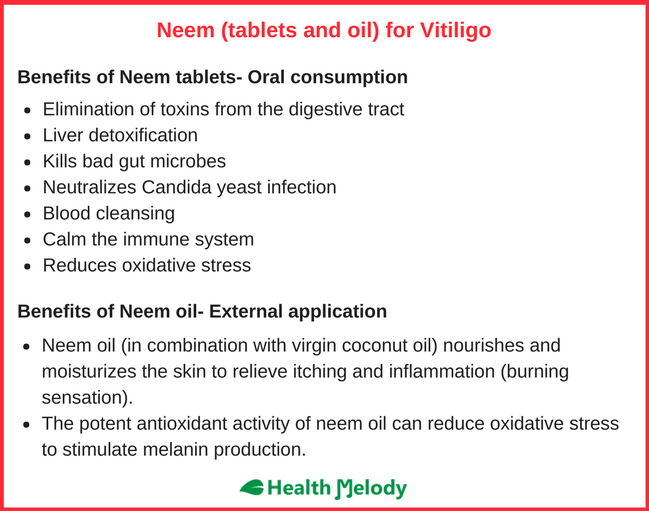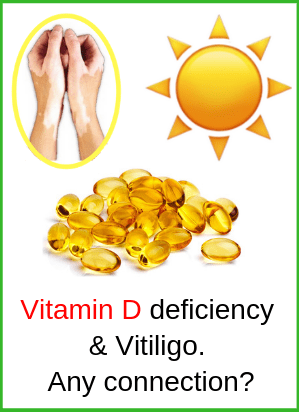
Does Neem help with Vitiligo healing
Does neem help with vitiligo? I would say- yes, it helps when taken as a supplement along with a healthy diet, positive lifestyle, stress management and consumption of anti-inflammatory dietary supplements and natural herbs.
Neem (Botanical name- Azadirachta Indica) is a medicinal tree native to India, Myanmar and other South Asian countries. In India, it is also known as ‘Village dispensary’ because almost every part of this tree is used as a folk remedy for various health issues. Neem leaves, bark, roots, seeds, flowers- every part got therapeutic potential. It is one of the most researched medicinal tree and modern scientists have identified more than 140 compounds in various parts of neem tree and many of them have therapeutic benefits, including anti-inflammatory, immunomodulating, antioxidant, anti-fungal, anti-bacterial, anti-viral and anti-carcinogenic properties. (1)
Various therapeutic benefits of Neem include (2, 3):
- Blood purification
- Body detox
- Treats skin disorders
- Regulates blood sugar
- Kills intestinal worms
- Anti-Candida activity
- Reduces gut inflammation
- Calms the immune system
- Healthy respiratory system
- Treats dental cavities and bad breath
- Reduces the problem of water retention in the body
- Soft, supple skin and healthy, lustrous hairs (when applied externally)
Many of the skin ailments are triggered by excessive body heat and blood impurity. From Ayurveda point of view, neem is a bitter herb with cold, light and dry qualities. It balances pitta and kapha doshas to reduce excess body heat and ama (body toxins). It has a wonderful cooling effect on the body. That’s why neem is called as ‘Queen of skin’ in Ayurveda. However, its potential to treat autoimmune skin disorders like vitiligo is not fully explored yet.
Neem for Vitiligo
Vitiligo is an autoimmune skin condition- the immune system, whose primary responsibility is to protect the body from external threats, gets faulty and starts attacking the body’s own healthy skin cells. The destruction of these pigment producing skin cells, also known as melanocytes, result in skin de-pigmentation in the form of white patches on various areas of the body.
The exact cause for the autoimmunity is not known yet. However, various possible causes include:
- Chronic stress
- Poor gut health (constipation, indigestion, lack of healthy gut bacteria, low stomach acid)
- Nutritional deficiencies
- Faulty genes (hereditary)
- Respiratory system related infections (such as strep throat)
- Skin injuries
- Overuse of steroids and antibiotics
- Alcohol abuse
- Poor diet and lifestyle
- Heavy metal toxicity due to pesticides and contaminated water
In natural healing, all autoimmune health issues, including vitiligo are directly linked to poor gut health because more than 70% of the immune system lies in the gut. (4) The gut refers to the whole gastrointestinal tract from mouth to the anus. The relation between a compromised gut health and autoimmunity can be explained with the help of a phenomenon ‘Leaky gut syndrome’.
Leaky gut, as the name suggests, means leakage in the gut. The lining (walls) of human gut is a net like structure with extremely small holes to allow the passage of micro food nutrients into the bloodstream. It restricts the toxins (bigger particles of unhealthy gut microbes, undigested food and other heavy metals etc) from entering the bloodstream. However, if the tight junctions of gut lining get damaged, it would be easier for these toxins to leak into the blood stream to pollute it. Such a high level of blood impurity triggers the immune system to overreact and it starts attacking body’s own skin cells by mistake.
The major culprits for damage in gut walls are:
- Poor elimination of metabolic body wastage (chronic constipation)
- Overgrowth of bad gut bacteria and Candida (yeast overgrowth)
- Poor digestion due to low stomach acid and weak digestive fire
- Liver impairment and congestion
- Deficiency of nutrients which are required to maintain the structural integrity of gut wall
How neem can help here- Internal consumption of Neem tablets
- According to Dr Mehmet Oz, Neem is a powerful blood cleanser with significant antimicrobial properties to neutralize the parasites and bad bugs in the gut. It removes the toxins from the body and support proper liver function. (5)
- The human gut contains trillions of microbes. Among these naturally occurring microbes, a delicate balance exists between the good ones (probiotics) and the bad ones (pathogens). If the pathogens outnumber the probiotics, it would result in indigestion, damage to the gut walls and autoimmunity. Neem got the potential to kill these overpopulated bad gut microbes to set the house in order. Traditionally, it is used to kill the intestinal worms. The anti-yeast, antibacterial, antifungal and antiviral properties of neem are well studied. It has nimbidin, gedunin, nimbin, and other compounds. (3, 6, 7)
- Due to its bitter taste, neem awakens the digestive fire for optimum digestion. It reduces inflammation in the whole gastrointestinal tract (gut) to relieve acid reflux, inflammatory bowel diseases and gastric disorders.
Good to know- Antioxidant activity of Neem
All the parts of neem tree got antioxidant activity due to a variety of polyphenols. (8, 9, 10) An unpublished study conducted at Brunswick Laboratories observed that neem’s antioxidant activity is 4 times higher than blueberries and 5 times higher than cranberries. (11) Such a powerful antioxidant activity can reduce oxidative stress to calm down the immune system and prevent autoimmune reaction.
Neem oil for Skin- External application
Neem oil is extracted by the cold pressing of neem seeds. Thanks to Vitamin E, oleic acid and linoleic acid content, Neem oil lubricates and moisturizes the skin to relieve itching. (12) Due to Nimbidin and other active compounds, neem got potent anti-inflammatory activity. (3, 13) It reduces skin inflammation (burning sensation) to maintain comfortable body temperature. Hence, if you feel burning sensation and itching due to sunlight exposure on the vitiligo affected areas, regular application of neem oil can relieve these symptoms naturally.

Moreover, vitiligo is linked to high level of hydrogen peroxide in the epidermis (outermost layer of skin) due to oxidative stress. (14) Neem oil’s antioxidant properties can reduce the impact of oxidative stress to stimulate melanin production when used regularly. However, this claim is yet to be backed by research evidences.
How to use and Dosage
Neem tablets
Take it twice a day preferably with warm water.
For adults- 3000-4000 mg per day
For kids (up to 10 years) – 1000 mg per day
For small kids (below 10 years), do consult an Ayurveda doctor for dosage recommendations.
Prefer neem tablets over capsules because when you put neem tablets on your tongue, the taste buds send signals to the brain and stimulate the body metabolism to increase the herb’s effectiveness. Whereas in case of capsules, the taste buds can’t identify the taste.
Neem oil
Pure neem oil is highly potent in nature and has a strong unpleasant odor. So, you may choose to dilute it with virgin coconut oil before applying to the skin. For example- 2 parts of neem oil with 8 parts of virgin coconut oil.
From where to buy
Use pure, organic Neem products of reputed brands for good results.
| USA readers | India readers | UK readers | |
|---|---|---|---|
| Neem tablets | Click here | Click here | Click here |
| Neem oil | Click here | Click here | Click here |
Precautionary measures and Side effects
Neem oil should not be consumed internally. It is strictly for external use only.
Neem tablets are safe for the general population when consumed in moderation. However, pregnant women, breastfeeding ladies and people taking prescription medications to treat heart ailments, hypertension and other chronic disorders should consult their doctors before consuming it. Also, neem possesses contraceptive properties; if you are trying to conceive, neem is not suitable for you. (15)

Got further questions?
Send your questions at [email protected] and I will try to answer them.



